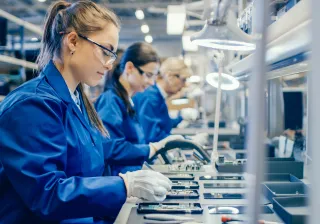The recycling targets set by the EU are tough and difficult to achieve with current technical solutions. The share of incineration of municipal waste, i.e. utilising it for energy, has increased in Finland to 62 per cent in recent years. A large part of it could be recycled, thus reducing CO2 emissions. To achieve the recycling targets, significant changes are needed, from legislation to consumers. VTT evaluates different methods for Vantaa Energy that would speed up the solution of the recycling challenge.
In 2021, the recycling rate of municipal waste was 37 per cent in Finland. The EU aims to raise the recycling rate to at least 60 per cent by 2030. There are two complementary ways to improve the current state of recycling: increase source separation in homes and other properties and build centralised waste sorting facilities in Finland. Both solutions come with their challenges. Yet it is clear that it would be unwise to put your eggs in one basket when it comes to solving the waste problem.
“The majority of municipal waste is fossil-based waste, such as plastic. For the climate, burning it is the same as using oil. Recycling must be increased, but that still leaves difficult-to-recycle material for incineration. So we need solutions for both carbon capture and more efficient recycling,” says Antti Arasto, VTT Vice President.
More extensive source separation faces hurdles with the slow change in customer behaviour, the quality of sorting and the distances involved in collection logistics—we do not know how much source separation can increase the recycling of municipal waste. Sorting facilities for municipal waste remain an untapped opportunity in Finland. The legislation does not consider all waste treated in sorting plants as fully recycled. The potential of technical solutions for plant sorting and the usability of the available waste streams require further studies.
Benefits of materials and products derived from waste should be maximised
The amount of municipal waste in Finland has increased by 30 per cent in the 2000s. Investments are also needed to reduce the amount of waste. The recyclability of products and their materials should be taken into account better already at the planning stage.
“In the future, the use of waste for incineration and energy is only recommended when the waste is genuinely unfit for recycling. More precise plant sorting could give us access to materials that can be further processed to create new raw materials and recycled products. For example, plenty of different types of plastics are still put into mixed waste despite separate collection, and separating them as a raw material for the chemical recycling of plastic could significantly increase the production of high-quality recycled plastic,” says Mika Härkönen, Professor of Practice at VTT.
Climate change mitigation, the recycling target and energy efficiency have many synergies, but compromises must also be made between conflicting objectives to keep the environmental and social impacts under control. A key question in EU-level decision-making is which part of waste can be recycled with sufficient quality and to what extent the use of carbon dioxide from waste incineration and its further processed products can be considered sustainably produced.
Vantaa Energy's goal is to promote the sustainable circulation of carbon and materials
Vantaa Energy, which aims to become a carbon-negative energy company by 2030 by means of circular economy, is working with VTT and other partners to find solutions to enable a sustainable carbon cycle in the society. For example, all valuable components in a bag of mixed waste should be recycled so that only the truly non-recyclable waste ends up incinerated in energy production. This would both improve the material and resource efficiency of waste recycling and contribute to climate objectives by reducing the need for energy recovery from waste. In addition to separate collection, there is a need for additional plant-based sorting, as highlighted by VTT’s analysis, for example, but the incineration of non-recyclable waste and carbon dioxide capture also have a role to play.
“Together with our partners, we are studying opportunities to utilise waste fractions in a way that generates the most value. Through the further processing of recycled products, we can recover process heat for the heating network as well as raw material or fuel used in industry. Although there is a great deal of potential in increasing the recycling rate, not all waste can be recycled. This so-called ‘reject waste’ should be recovered for energy with high efficiency, and carbon dioxide should be captured from it. This is an important part of a well-functioning circular economy and carbon cycle,” says Kalle Patomeri, Business Director of City Energy at Vantaa Energy.
The construction of new value chains that improve the carbon cycle relies on intersectoral cooperation. Vantaa Energy is actively seeking partners from both waste management companies and the processing industry to build a functional and sustainable circular economy ecosystem and to export VTT and other partners' solutions to the industrial environment.
Municipal waste: Municipal waste refers to waste generated in households and waste comparable to household waste generated in production, especially in the service industries. The general common feature of municipal waste is that it is generated in the consumption of final products in communities and is covered by municipal waste management systems.
VTT charted ways for Vantaa Energy to tackle the recycling challenge. Read VTT's report: Technical Steps Towards Circularity of Carbon-Containing Wastes







